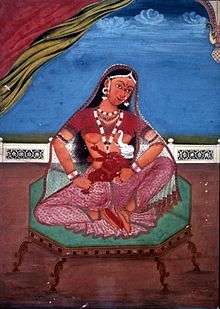Mother
A mother is the female parent of a child. Mothers are women who inhabit or perform the role of bearing some relation to their children, who may or may not be their biological offspring. Thus, dependent on the context, women can be considered mothers by virtue of having given birth, by raising their child(ren), supplying their ovum for fertilisation, or some combination thereof. Such conditions provide a way of delineating the concept of motherhood, or the state of being a mother. Women who meet the third and first categories usually fall under the terms 'birth mother' or 'biological mother', regardless of whether the individual in question goes on to parent their child. Accordingly, a woman who meets only the second condition may be considered an adoptive mother, and those who meet only the first or only the third a surrogacy mother.
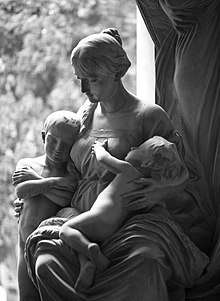
An adoptive mother is a female who has become the child's parent through the legal process of adoption. A biological mother is the female genetic contributor to the creation of the infant, through sexual intercourse or egg donation. A biological mother may have legal obligations to a child not raised by her, such as an obligation of monetary support. A putative mother is a female whose biological relationship to a child is alleged but has not been established. A stepmother is a female who is the wife of a child's father and they may form a family unit, but who generally does not have the legal rights and responsibilities of a parent in relation to the child.
The above concepts defining the role of mother are neither exhaustive nor universal, as any definition of 'mother' may vary based on how social, cultural, and religious roles are defined. The parallel conditions and terms for males: those who are (typically biologically) fathers do not, by definition, take up the role of fatherhood. Motherhood and fatherhood are not limited to those who are or have parented. Women who are pregnant may be referred to as expectant mothers or mothers-to-be, though such applications tend to be less readily applied to (biological) fathers or adoptive parents.[1][2] The process of becoming a mother has been referred to as "matrescence".[3]
The adjective "maternal" refers to a mother and comparatively to "paternal" for a father. The verb "to mother" means to procreate or to sire a child from which also derives the noun "mothering". Related terms of endearment are mom (mama, mommy), mum, mumsy, mamacita (ma, mam) and mammy. A female role model that children can look up to is sometimes referred to as a mother-figure.
Biological mother
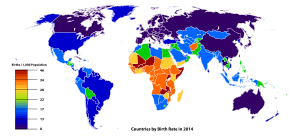
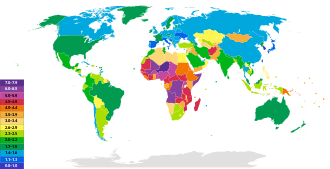
Biological motherhood for humans, as in other mammals, occurs when a pregnant female gestates a fertilized ovum (the "egg"). A female can become pregnant through sexual intercourse after she has begun to ovulate. In well-nourished girls, menarche (the first menstrual period) usually takes place around the age of 12 or 13.[4]
Typically, a fetus develops from the viable zygote, resulting in an embryo. Gestation occurs in the woman's uterus until the fetus (assuming it is carried to term) is sufficiently developed to be born. In humans, gestation is often around 9 months in duration, after which the woman experiences labor and gives birth. This is not always the case, however, as some babies are born prematurely, late, or in the case of stillbirth, do not survive gestation. Usually, once the baby is born, the mother produces milk via the lactation process. The mother's breast milk is the source of antibodies for the infant's immune system, and commonly the sole source of nutrition for newborns before they are able to eat and digest other foods; older infants and toddlers may continue to be breastfed, in combination with other foods, which should be introduced from approximately six months of age.[5]
Childlessness is the state of not having children. Childlessness may have personal, social or political significance. Childlessness may be voluntary childlessness, which occurs by choice, or may be involuntary due to health problems or social circumstances. Motherhood is usually voluntary, but may also be the result of forced pregnancy, such as pregnancy from rape. Unwanted motherhood occurs especially in cultures which practice forced marriage and child marriage.
Non-biological mother
Mother can often apply to a woman other than the biological parent, especially if she fulfills the main social role in raising the child. This is commonly either an adoptive mother or a stepmother (the biologically unrelated partner of a child's father). The term "othermother" or "other mother" is also used in some contexts for women who provide care for a child not biologically their own in addition to the child's primary mother.
Adoption, in various forms, has been practiced throughout history, even predating human civilization.[6] Modern systems of adoption, arising in the 20th century, tend to be governed by comprehensive statutes and regulations. In recent decades, international adoptions have become more and more common.
Adoption in the United States is common and relatively easy from a legal point of view (compared to other Western countries).[7] In 2001, with over 127,000 adoptions, the US accounted for nearly half of the total number of adoptions worldwide.[8]
Surrogate mother
A surrogate mother is a woman who bears a child that came from another woman's fertilized ovum on behalf of a couple unable to give birth to children. Thus the surrogate mother carries and gives birth to a child that she is not the biological mother of. Surrogate motherhood became possible with advances in reproductive technologies, such as in vitro fertilization.
Not all women who become pregnant via in vitro fertilization are surrogate mothers. Surrogacy involves both a genetic mother, who provides the ovum, and a gestational (or surrogate) mother, who carries the child to term.
Motherhood in same-sex relationships
The possibility for lesbian and bisexual women in same-sex relationships (or women without a partner) to become mothers has increased over the past few decades due to technological developments. Modern lesbian parenting (a term that somewhat erases the bisexual case) originated with women who were in heterosexual relationships who later identified as lesbian or bisexual, as changing attitudes provided more acceptance for non-heterosexual relationships. Another way for such women to become mothers is through adopting or foster parenting. There is also the option of self-insemination and clinically assisted donor insemination, forms of artificial insemination. As fertility technology has advanced, more females not in a heterosexual relationship have become mothers through in vitro fertilization.[9][10]
Social role
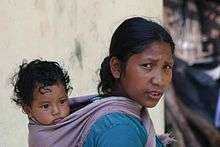
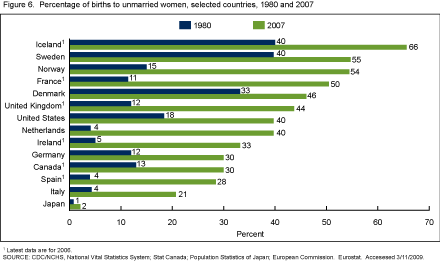

The social roles associated with motherhood are variable across time, culture, and social class. [13] Historically, the role of women was confined to some extent to being a mother and wife, with women being expected to dedicate most of their energy to these roles, and to spend most of their time taking care of the home. In many cultures, women received significant help in performing these tasks from older female relatives, such as mothers in law or their own mothers.[14]
Regarding women in the workforce, mothers are said to often follow a "mommy track" rather than being entirely "career women". Mothers may be stay at home mothers or working mothers. In recent decades there has been an increase in stay at home fathers too. Social views on these arrangements vary significantly by culture: in Europe for instance, in German-speaking countries there is a strong tradition of mothers exiting the workforce and being homemakers.[15] Mothers have historically fulfilled the primary role in raising children, but since the late 20th century, the role of the father in child care has been given greater prominence and social acceptance in some Western countries.[16][17] The 20th century also saw more and more women entering paid work. Mothers' rights within the workforce include maternity leave and parental leave.
The social role and experience of motherhood varies greatly depending upon location. Mothers are more likely than fathers to encourage assimilative and communion-enhancing patterns in their children.[18] Mothers are more likely than fathers to acknowledge their children's contributions in conversation.[19][20][21][22] The way mothers speak to their children ("motherese") is better suited to support very young children in their efforts to understand speech (in context of the reference English) than fathers.[19]
Since the 1970s, in vitro fertilization has made pregnancy possible at ages well beyond "natural" limits, generating ethical controversy and forcing significant changes in the social meaning of motherhood.[23][24] This is, however, a position highly biased by Western world locality: outside the Western world, in-vitro fertilization has far less prominence, importance or currency compared to primary, basic healthcare, women's basic health, reducing infant mortality and the prevention of life-threatening diseases such as polio, typhus and malaria.
Traditionally, and still in most parts of the world today, a mother was expected to be a married woman, with birth outside of marriage carrying a strong social stigma. Historically, this stigma not only applied to the mother, but also to her child. This continues to be the case in many parts of the developing world today, but in many Western countries the situation has changed radically, with single motherhood being much more socially acceptable now. For more details on these subjects, see Legitimacy (family law) and single parent.
The total fertility rate (TFR), that is, the number of children born per woman, differs greatly from country to country. The TFR in 2013 was estimated to be highest in Niger (7.03 children born per woman) and lowest in Singapore (0.79 children/woman).[25]
In the United States, the TFR was estimated for 2013 at 2.06 births per woman.[25] In 2011, the average age at first birth was 25.6 and 40.7% of births were to unmarried women.[26]
Health and safety issues

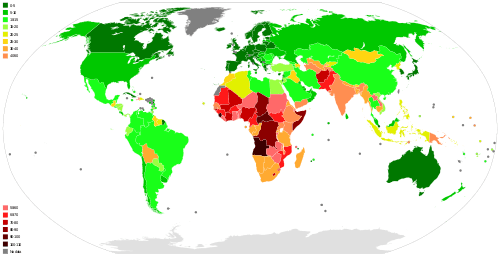
.jpg)
A maternal death is defined by WHO as "the death of a woman while pregnant or within 42 days of termination of pregnancy, irrespective of the duration and site of the pregnancy, from any cause related to or aggravated by the pregnancy or its management but not from accidental or incidental causes".[27]
About 56% of maternal deaths occur in Sub-Saharan Africa and another 29% in South Asia.[28]
In 2006, the organization Save the Children has ranked the countries of the world, and found that Scandinavian countries are the safest places to give birth, whereas countries in sub-Saharan Africa are the least safe to give birth.[29] This study argues a mother in the bottom ten ranked countries is over 750 times more likely to die in pregnancy or childbirth, compared to a mother in the top ten ranked countries, and a mother in the bottom ten ranked countries is 28 times more likely to see her child die before reaching their first birthday.
The most recent data suggests that Italy, Sweden and Luxembourg are the safest countries in terms of maternal death and Afghanistan, Central African Republic and Malawi are the most dangerous.[30][31]
Childbirth is an inherently dangerous and risky process, subject to many complications. The "natural" mortality rate of childbirth—where nothing is done to avert maternal death—has been estimated as being 1500 deaths per 100,000 births.[32] Modern medicine has greatly alleviated the risk of childbirth. In modern Western countries the current maternal mortality rate is around 10 deaths per 100,000 births.[33]
Religious
Nearly all world religions define tasks or roles for mothers through either religious law or through the glorification of mothers who served in substantial religious events. There are many examples of religious law relating to mothers and women.
Major world religions which have specific religious law or scriptural canon regarding mothers include: Christianity,[34] Judaism,[35] and Islam.[36] Some examples of honoring motherhood include the Madonna or Blessed Virgin Mother Mary for Catholics, and the multiple positive references to active womanhood as a mother in the Book of Proverbs.
Hindu's Mother Goddess and Demeter of ancient Greek pre-Christian belief are also mothers.
Mother-offspring violence
_-_Google_Art_Project.jpg)
History records many conflicts between mothers and their children. Some even resulted in murder, such as the conflict between Cleopatra III of Egypt and her son Ptolemy X.
In modern cultures, matricide (the killing of one's mother) and filicide (the killing of one's son or daughter) have been studied but remain poorly understood. Psychosis and schizophrenia are common causes of both,[37][38] and young, indigent mothers with a history of domestic abuse are slightly more likely to commit filicide.[38][39] Mothers are more likely to commit filicide than fathers when the child is 8 years old or younger.[40] Matricide is most frequently committed by adult sons.[41]
In the United States in 2012, there were 130 matricides (0.4 per million people) and 383 filicides (1.2 per million), or 1.4 incidents per day.[42]
In art
_-_Charity_(1878).jpg)
.jpg)
Throughout history mothers with their children have often been the subject of artistic works, such as paintings, sculptures or writings.
Fourth century grave reliefs on the island of Rhodes depicted mothers with children.[43]
Paintings of mothers with their children have a long tradition in France. In the 18th century, these works embodied the Enlightenment's preoccupation with strong family bonds and the relation between mothers and children.[44]
At the end of the nineteenth century, Mary Cassatt was a painter well known for her portraits of mothers.
Many contemporary movies portray mothers.
Synonyms and translations
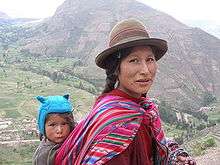

The proverbial "first word" of an infant often sounds like "ma" or "mama". This strong association of that sound with "mother" has persisted in nearly every language on earth, countering the natural localization of language.
Familiar or colloquial terms for mother in English are:
- Ma(মা), Amma (আম্মা), Ammu (আম্মু) used in Bangladesh
- Aama, Mata used in Nepal
- Mom and mommy are used in the United States, Canada, South Africa, India and parts of the West Midlands including Birmingham in the United Kingdom.
- Inay, Nanay, Mama, Ma, Mom, Mommy are used in the Philippines
- Mum and mummy and mama are used in the United Kingdom, Canada, Singapore, Australia, New Zealand, India, Pakistan, Hong Kong and Ireland.
- Ma, mam, and mammy are used in Netherlands, Ireland, the Northern areas of the United Kingdom, and Wales; it is also used in some areas of the United States.
In many other languages, similar pronunciations apply:
- Amma (அம்மா) or Thai (தாய்) in Tamil
- Maa, aai, amma, and mata are used in languages of India like Assamese, Hindi, Marathi, Tamil, Telugu etc.
- Mamá, mama, ma, and mami in Spanish
- Mama in Polish, German, Dutch, Russian and Slovak
- Māma (妈妈/媽媽) in Chinese
- Máma in Czech and in Ukrainian
- Maman in French and Persian
- Ma, mama in Indonesian
- Mamaí, mam in Irish
- Mamma in Italian, Icelandic, Latvian and Swedish
- Māman or mādar in Persian
- Mamãe or mãe in Portuguese
- Mā̃ (ਮਾਂ) in Punjabi
- Mama in Swahili
- Em (אם) in Hebrew
- A'ma (ܐܡܐ) in Aramaic
- Má or mẹ in Vietnamese
- Mam in Welsh
- Eomma (엄마, pronounced [ʌmma]) in Korean
- In many south Asian cultures and the Middle East, the mother is known as amma, oma, ammi or "ummi", or variations thereof. Many times, these terms denote affection or a maternal role in a child's life.
Etymology

The modern English word is from Middle English moder, from Old English mōdor, from Proto-Germanic *mōdēr (cf. East Frisian muur, Dutch moeder, German Mutter), from Proto-Indo-European *méh₂tēr (cf. Irish máthair, Tocharian A mācar, B mācer, Lithuanian mótė). Other cognates include Latin māter, Greek μήτηρ, Common Slavic *mati (thence Russian мать (mat’)), Persian مادر (madar), and Sanskrit मातृ (mātṛ).
Notable mothers
See also
- Advanced maternal age
- Attachment parenting
- Blessed Virgin Mary
- Breastfeeding
- Jungian archetypes
- Lactation
- Maternal bond
- Maternity package
- Matriarch
- Matricide
- Matrilocal residence
- Mother goddess
- Mother Goose
- Mother insult
- motherhood penalty
- Mother ship
- Mother's Day
- Mothers' rights
- Nuclear family
- Oedipus complex
- Othermother
- Parenting
- Single-parent
References
- "definition of mother from Oxford Dictionaries Online". Oxford Dictionaries. Oxford University Press.
- "Define Mother at Dictionary.com". Dictionary.com.
- Sacks, Alexandra (8 May 2017). "The Birth of a Mother". Retrieved 9 September 2018.
- "Medscape: Medscape Access".
- "Your baby's first solid foods". nhs.uk. 2017-12-21. Retrieved 2018-12-17.
- Peter Conn (28 January 2013). Adoption: A Brief Social and Cultural History. Palgrave Macmillan. pp. 25–64. ISBN 978-1-137-33390-2.
- Jardine, Cassandra (31 Oct 2007). "Why adoption is so easy in America". Telegraph.
- "Child Adoption : Trends and Policies" (PDF). Un.org. Retrieved 2015-07-01.
- "Lesbian parenting: issues, strengths and challenges". Retrieved 2011-01-25.
- Mezey, Nancy J (2008). New Choices, New Families: How Lesbians Decide about Motherhood. Baltimore: Johns Hopkins University Press. ISBN 978-0-8018-9000-0.
- "Changing Patterns of Nonmarital Childbearing in the United States". CDC/National Center for Health Statistics. May 13, 2009. Retrieved September 24, 2011.
- Website list Archived 2011-03-23 at the Wayback Machine
- Arendell, Terry (2000). "Conceiving and Investigating Motherhood: The Decade's Scholarship". Journal of Marriage and Family. 62 (4): 1192–1207. doi:10.1111/j.1741-3737.2000.01192.x.
- "The Changing Role of Women in North American Mammalogy" (PDF). Biology.unm.edu. Retrieved 2015-07-01.
- "Has childlessness peaked in Europe?" (PDF). Ined.fr. Retrieved 17 December 2017.
- Archived August 15, 2013, at the Wayback Machine
- "ucgstp.org". Ucgstp.org. Archived from the original on 2008-02-25. Retrieved 2015-07-01.
- Ann M. Berghout Austin1 and T.J. Braeger2 (1990-10-01). "Gendered differences in parents' encouragement of sibling interaction: implications for the construction of a personal premise system". Fla.sagepub.com. Retrieved 2011-10-27.
- "Fathers' speech to their children: perfect pitch or tin ear?". Thefreelibrary.com. Retrieved 2011-10-27.
- Hladik, E.; Edwards, H. (1984). "A comparison of mother-father speech in the naturalistic home environment". Journal of Psycholinguistic Research. 13: 321–332. doi:10.1007/bf01068149.
- Leaper, C.; Anderson, K.; Sanders, P. (1998). "Moderators of gender effects on parents' talk to their children: A meta-analysis". Developmental Psychology. 34 (1): 3–27. doi:10.1037/0012-1649.34.1.3. PMID 9471001.
- Mannle, S.; Tomasello, M. (1987). "Fathers, siblings, and the bridge hypothesis". In Nelson, K. E.; vanKleeck, A. (eds.). Children's language. 6. Hillsdale, NJ: Erlbaum. pp. 23–42.
- "Motherhood: Is It Ever Too Late? | Jacob M. Appel". Huffingtonpost.com. 2009-08-15. Retrieved 2015-07-01.
- "Getting Pregnant After 50: Risks, Rewards". Huffingtonpost.com. 2009-08-17. Retrieved 2015-07-01.
- "The World Factbook". cia.gov.
- "FastStats". cdc.gov.
- "WHO - Maternal mortality ratio (per 100 000 live births)". who.int.
- "Over 99 percent of maternal deaths occur in developing countries". worldbank.org.
- Archived October 12, 2007, at the Wayback Machine
- Kevin Spak. "Safest Place to Give Birth? Italy". Newser.
- Rogers, Simon (2010-04-13). "Maternal mortality: how many women die in childbirth in your country?". The Guardian.
- Van Lerberghe W, De Brouwere V. Of blind alleys and things that have worked: history’s lessons on reducing maternal mortality. In: De Brouwere V, Van Lerberghe W, eds. Safe motherhood strategies: a review of the evidence. Antwerp, ITG Press, 2001 (Studies in Health Services Organisation and Policy, 17:7–33). "Where nothing effective is done to avert maternal death, "natural" mortality is probably of the order of magnitude of 1,500/100,000."
- ibid, p10
- "What The Bible Says About Mother". Mothers Day World. Retrieved 2008-11-24.
- Katz, Lisa. "Religious Obligations of Jewish women". About.com. Retrieved 2008-11-24.
- 'Ali Al-Hashimi, Muhammad. The Ideal Muslimah: The True Islâmic Personality of the Muslim Woman as Defined in the Qur'ân and Sunnah. Wisdom Enrichment Foundation, Inc. Archived from the original on 2002-03-02. Retrieved 2008-11-24.
- Bourget, Dominique; Gagné, Pierre; Labelle, Mary-Eve (September 2007). "Parricide: A Comparative Study of Matricide Versus Patricide". Journal of the American Academy of Psychiatry and the Law. 35 (3): 306–312. PMID 17872550. Retrieved 2 July 2015.
- West, Sara G. (Feb 2007). "An Overview of Filicide". Psychiatry. 4 (2): 48–57. PMC 2922347. PMID 20805899.
- Friedman, SH; Horwitz, SM; Resnick, PJ (Sep 2005). "Child murder by mothers: a critical analysis of the current state of knowledge and a research agenda". American Journal of Psychiatry. 162 (9): 1578–87. doi:10.1176/appi.ajp.162.9.1578. PMID 16135615.
- Greenfeld, Lawrence A., Snell, Tracy L. (1999-02-12, updated 2000-03-10). "Women Offenders". NCJ 175688. US Department of Justice
- Heide, KM (Mar 2013). "Matricide and stepmatricide victims and offenders: an empirical analysis of U.S. arrest data". Behavioral Sciences & the Law. 31 (2): 301–14. doi:10.1002/bsl.2056. PMID 23558726.
- "Crime in the United States: Murder Circumstances by Relationship, 2012". U.S. Federal Bureau of Investigation. Retrieved 3 July 2015.
- Women, Crime and Punishment in Ancient Law and Society, p. 234, at Google Books
- Intimate Encounters: Love and Domesticity in Eighteenth-century France, p. 87, at Google Books
Further reading
- Thornhill, Randy; Gangestad, Steven W. The Evolutionary Biology of Human Female Sexuality.
- Manne, Anne. Motherhood – How should we care for our children?.
- Hrdy, Sarah Blaffer. Mother nature: maternal instincts and how they shape the human species.

